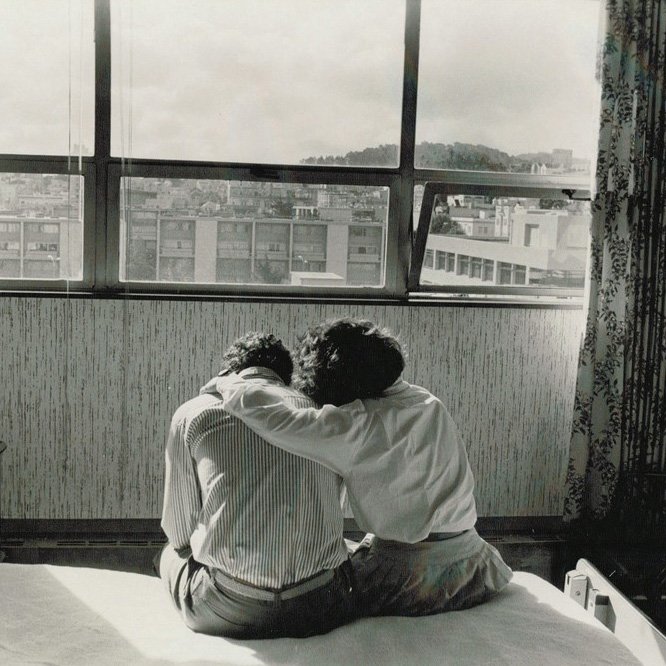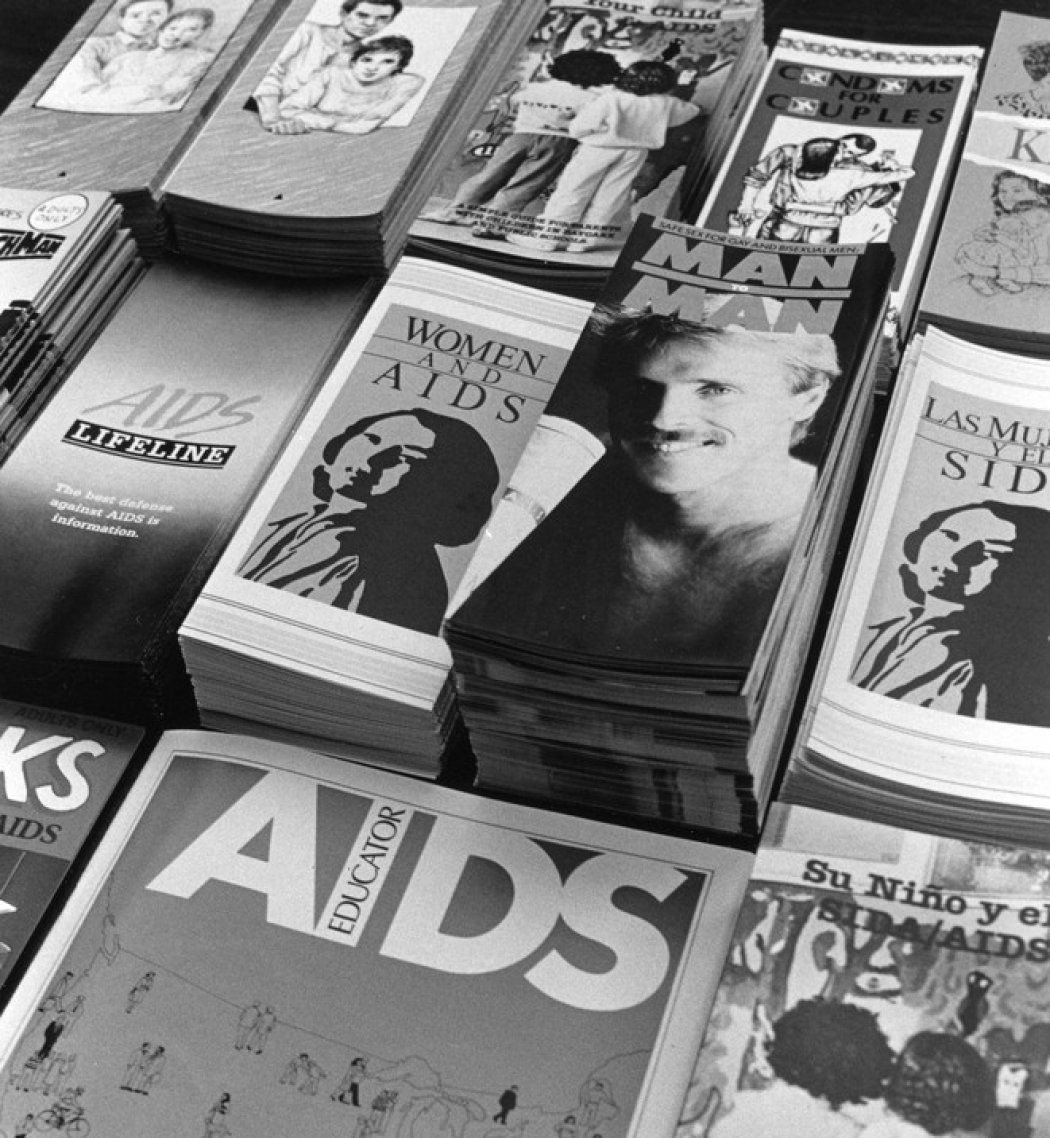Over the past four decades, UCSF has led the way in its heroic and committed response to the AIDS epidemic, both locally and globally. This timeline covers some of the highlights over the past 40 years at UCSF, in the nation and around the world after a mysterious outbreak affecting gay men was first reported on June 5, 1981.
1981
- UCLA’s Michael Gottlieb, MD, and others author the first report identifying the appearance of diseases that would later become known as AIDS on June 5.
- On June 30, the U.S. Centers for Disease Control (CDC) and Prevention forms a Task Force on Kaposi’s Sarcoma and Opportunistic Infections.
- UCSF’s Paul Volberding, MD, sees his first patient with Kaposi’s sarcoma (KS), a rare cancer later linked to AIDS, on his first day on the faculty at San Francisco General Hospital (SFGH) on July 1.
- On July 3, the CDC reports that 26 gay men, ranging in age from 26 to 51, have been diagnosed with KS during the past 30 months, and eight died within 24 months.
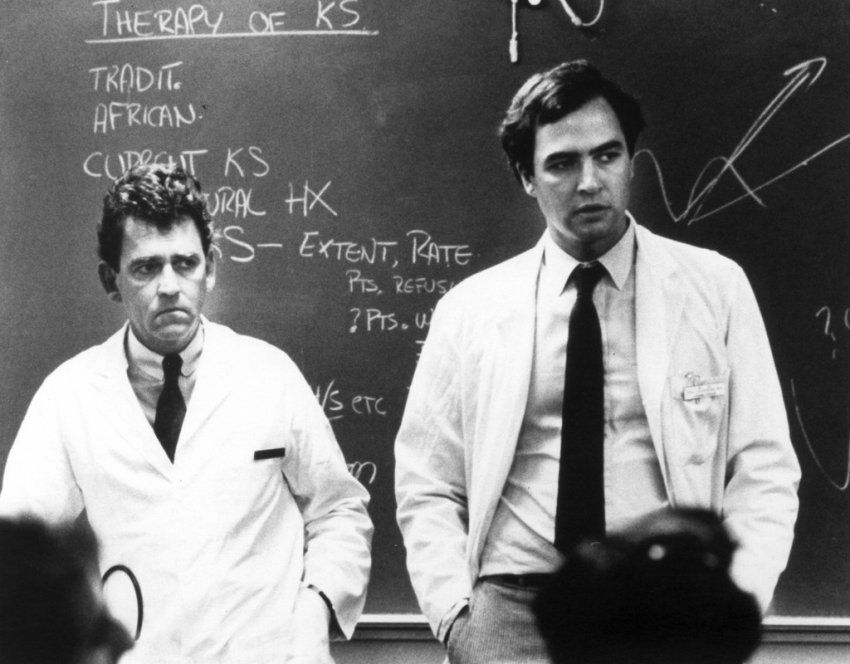
Marcus Conant (left) and Paul Volberding discussing Kaposi's Sarcoma.
1982
- The CDC uses the term acquired immune deficiency syndrome (AIDS) for the first time on September 24.
- The City and County of San Francisco, working closely with UCSF health professionals at SFGH, the San Francisco AIDS Foundation and others, develops the San Francisco “model of care,” which emphasizes patient centered care that included home and community-based services.
- U.S. Congress convenes first hearings on HIV/AIDS.
- The San Francisco AIDS Foundation was founded as a nonprofit organization dedicated to providing services for people with HIV/AIDS with a mission to end the epidemic in the United States.
- UCSF’s John Greenspan, BDS, PhD, is first to describe hairy leukoplakia, an oral lesion, as AIDS precursor, as well as other oral manifestations of the disease, findings he published in 1984; and first to identify the role of Epstein Barr virus in causing lesion in 1985.
1983
- UCSF faculty physicians open the country’s first outpatient AIDS clinic, Ward 86 in January, and inpatient Ward 5B in July, at SFGH.
- The CDC establishes the National AIDS Hotline to respond to public inquiries and reports in March that most cases of AIDS have been among gay men, injection drug users, Haitians and people with hemophilia.
- On September 9, the CDC identifies all major routes of transmission; says the virus is not transmitted through casual contact, food, water, air or environmental surfaces.
- UCSF’s Jay Levy, MD, and his colleagues in the Laboratory for Tumor and AIDS Virus Research, co-discover HIV as the cause for AIDS. He and his team go on to make many of the first observations in AIDS research, including demonstrating that HIV grew in cells other than in the lymphocytes and isolating the virus in the brain and the bowels.
- AIDS activist Bobbi Campbell appears with his partner Bobby Hilliard on the cover of Newsweek titled “Gay America: Sex, Politics and the Impact of AIDS.” Campbell dies the following year.
1984
- Ryan White, a 13-year-old hemophiliac from Indiana, becomes infected with HIV from a contaminated blood treatment.
- UCSF’s Deborah Greenspan, DSc, BDS, introduces rational, safe infection control protocols in the School of Dentistry, pushing UCSF at the forefront nationwide.
- The CDC identifies that needle sharing is a transmission method on July 13.
- San Francisco closes its bath houses followed by New York.
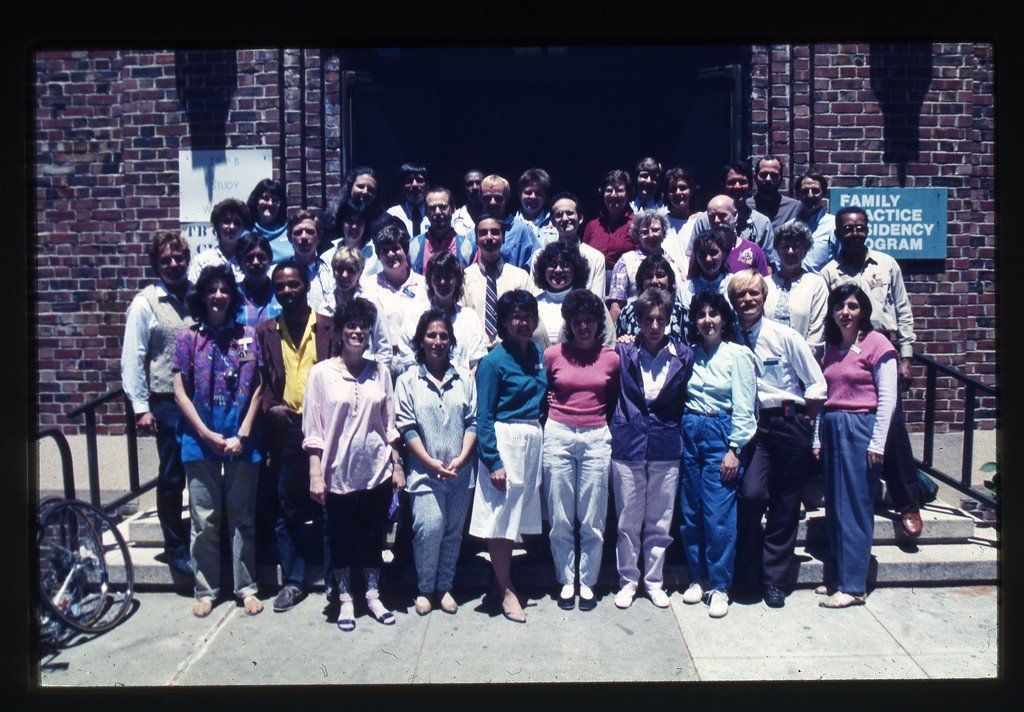
In 1985, the staff of SFGH Wards 84 and 86 pose for a photo outside.
1985
- UCSF’s Donald Abrams, MD, is instrumental in establishing a network of Bay Area clinicians, called the Community Consortium, which pioneers a new model of community-based clinical trials.
- The U.S. Food and Drug Administration (FDA) licenses the first HIV test for screening blood supplies.
- The CDC hosts the first presentation on AIDS in Africa in Atlanta, GA.
- Movie star Rock Hudson announces that he has AIDS and dies, becoming the first major celebrity to succumb to the disease.
- The U.S. Department of Health and Human Services and the World Health Organization (WHO) host the First International AIDS Conference in Atlanta. These annual conferences continue today.
- Ryan White, the Indiana boy who contracted AIDS through a blood transfusion, is barred from school and becomes a national spokesperson against AIDS stigma and discrimination.
- American Foundation for AIDS Research is founded with the help of movie star Elizabeth Taylor.
1986
- With the awarding of a National Institutes of Mental Health AIDS Center grant designed to boost AIDS prevention research, UCSF’s Center for AIDS Prevention officially opens its doors under the direction of Stephen Hulley, MD.
- More than 38,000 cases of AIDS are reported from 85 countries.
- Elected in late 1980, President Ronald Reagan first mentions the word AIDS in public.
- National Academy of Sciences report criticizes U.S. response to the epidemic and calls for $2 billion investment to combat the disease.
- The first clinical trials of antiviral drug azidothymidineor AZT begin.
- U.S. Surgeon General Everett Koop, MD, issues report on AIDS calling for nationwide education campaign (including sex education in schools) and increased use of condoms and voluntary testing on October 22.
- Institute of Medicine report calls for expanding education campaign and creating the National Commission on AIDS.
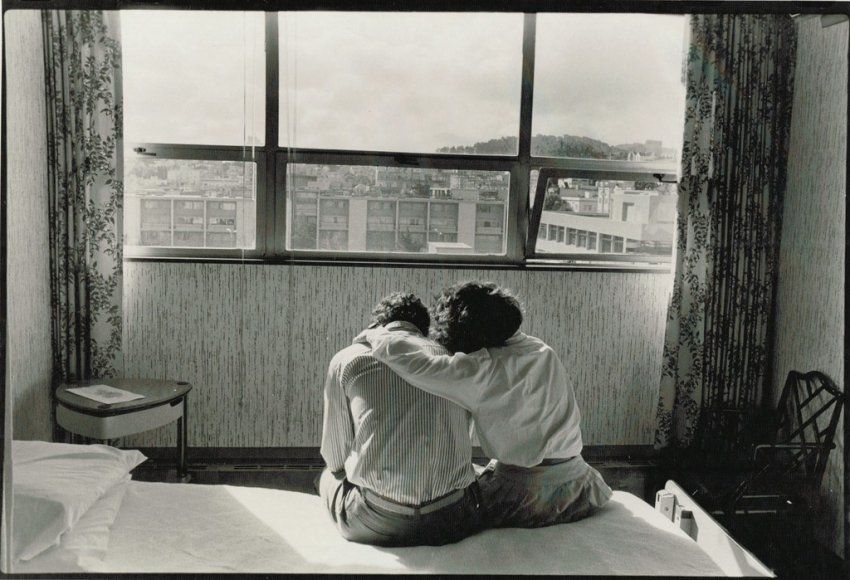
A patient and their loved one embrace in a room of the Medical Center at Mount Zion in 1987.
1987
- The San Francisco AIDS Foundation organizes the San Francisco AIDS Walk to raise funds for patient care, research and education. UCSF participates in the walk from the start.
- UCSF’s Donald Abrams, MD, confirms, with the help of the Community Consortium of Bay Area physicians, that giving the drug pentamidine in aerosol form was a more effective way of treating a serious from of pneumonia that typically strikes AIDS patients.
- UCSF’s Diane Havlir, MD, completes her residency at UCSF Medical Center and San Francisco General Hospital, launching her career-long research to developing therapeutic and prevention strategies to respond to global infectious diseases, including HIV and COVID-19.
- FDA approves a new drug to treat HIV, azidothymidine, known as AZT.
- CDC launches first public service announcements “America Responds to AIDS” and holds its first national conference on HIV in Communities of Color in New York.
- Organizers display an AIDS memorial quilt for the first time at the National Mall in Washington, DC.
- U.S. adds HIV as a “dangerous contagious disease” to its immigration exclusion list.
1988
- A group of UCSF researchers, including Diane Wara, MD, design a study that involved treating mothers with AZT from the second trimester onward, as well as at the time of delivery, and treating the infant with oral AZT. The study proved enormously effective, and reduces mother-to-infant transmission from 26 percent to 8 percent.
- A brochure titled “Understanding AIDS” is mailed to every household in the U.S.
- WHO declares first World AIDS Day on December 1, which continues today.
- The City and County of San Francisco establishes what becomes the nation’s largest needle exchange program.
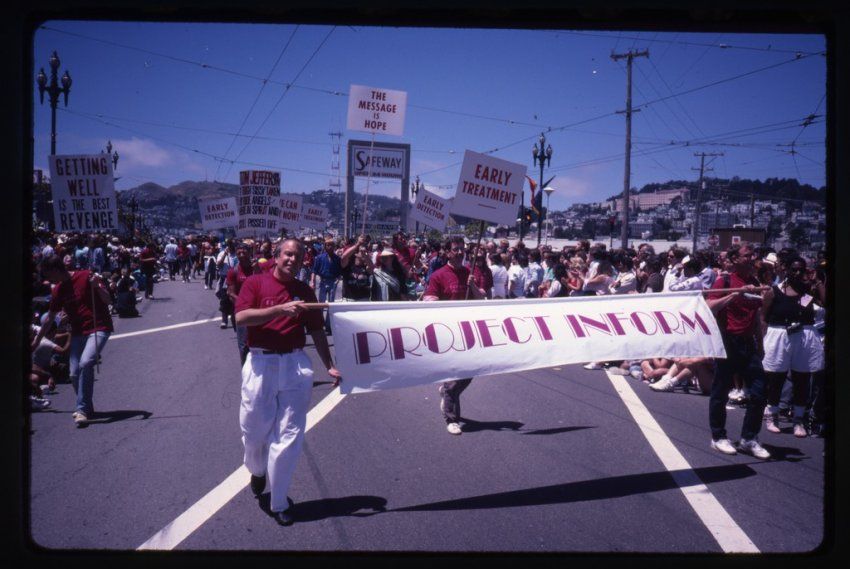
Project Inform, an American advocacy group dedicated to empowering people with HIV, marches in the San Francisco Lesbian and Gay Freedom Day Parade in 1988.
1989
- UCSF’s Paul Volberding, MD, finds that HIV-infected patients without symptoms of AIDS could have those symptoms delayed if they took the drug AZT.
- U.S. Congress creates the National Commission on AIDS.
- AIDS activists come out to protest about AIDS drugs, including demonstrating on San Francisco’s Golden Gate Bridge.
- CDC issues first guidelines for preventing Pneumocystis carinii pneumonia (PCP).
1990
- FDA approves use of AZT for pediatric AIDS.
- Americans with Disabilities Act enacted by Congress prohibits discrimination against individuals with disabilities, including those infected with HIV/AIDS.
- Congress passes the Ryan White CARE (Comprehensive AIDS Resources Emergency) Act, shortly before his death. The act will be reauthorized in 2006 and again in 2009. Ryan White programs became the largest provider of services for people living with HIV/AIDS in the U.S.
- CDC reports possible transmission of HIV to a patient through a dental procedure performed by a dentist living with HIV on July 27.
- Ryan White dies of AIDS at age 18 – a month before his high school graduation.
1991
- UCSF’s Nancy Padian, PhD, MPH, finds that HIV is much more likely to be passed sexually from males to females than vice versa and confirms the conclusion with a 10-year study of heterosexual transmission of the disease.
- Native San Franciscan Eric Goosby, who earned MD at UCSF in 1978, begins his government career as director of HIV Services at the Health Resources and Services Administration in the U.S. Department of Health and Human Services to administer the newly authorized Ryan White CARE action.
- The UCSF International Center for HIV/AIDS Research and Clinical Training in Nursing, a multidisciplinary research and education program dedicated to improving nursing care for people with and at risk for HIV opens.
- On July 12, the CDC issues recommendations for health care workers with HIV.
- U.S. introduces the red ribbon as the international symbol of AIDS awareness at the Tony Awards on Broadway.
- Freddie Mercury, lead singer of the rock band Queen, dies of AIDS.
- Los Angeles Lakers basketball great Earvin "Magic" Johnson retires abruptly after announcing that he had contracted HIV, but returned to play in the 1992 All-Star Game, winning the All-Star MVP Award.
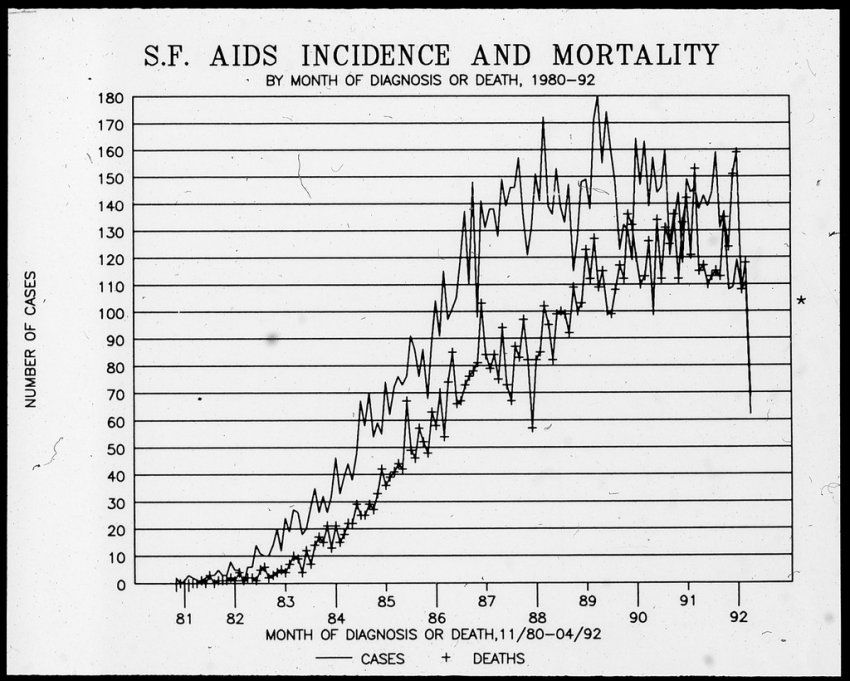
1992
- CDC reports that AIDS is the No. 1 cause of death for U.S. men ages 25 to 44 and cases peak in San Francisco with 2,332 that year.
- Tennis star Arthur Ashe announces he has AIDS.
1993
- UCSF’s Merle Sande, MD, proves instrumental in bringing together the State of California, the City and County of San Francisco, UCSF, SFGH, and the Gladstone Foundation to build and fund the Gladstone Institute of Virology and Immunology (GIVI), a research institute dedicated to the study of virology and immunology with a focus on HIV and AIDS.
- The Women’s Interagency HIV Study and HIV Epidemiology Study begin; both are major U.S. federally funded research studies on HIV/AIDS.
- CDC initiates HIV prevention community planning process to better target local prevention efforts.
1994
- UCSF’s Ruth Greenblatt, MD, and her team create the Women’s HIV Program (WHP), an innovative, multidisciplinary program specifically for women, designed to meet their unique health issues.
- AIDS becomes leading cause of death for all Americans ages 25 to 44.
- Elizabeth Glaser, founder of the Pediatric AIDS Foundation, dies of AIDS.
- UCSF Magazine reports facts and first in UCSF’s response to AIDS.
- CDC publishes guidelines for preventing HIV transmission through tissue and organ transplants.
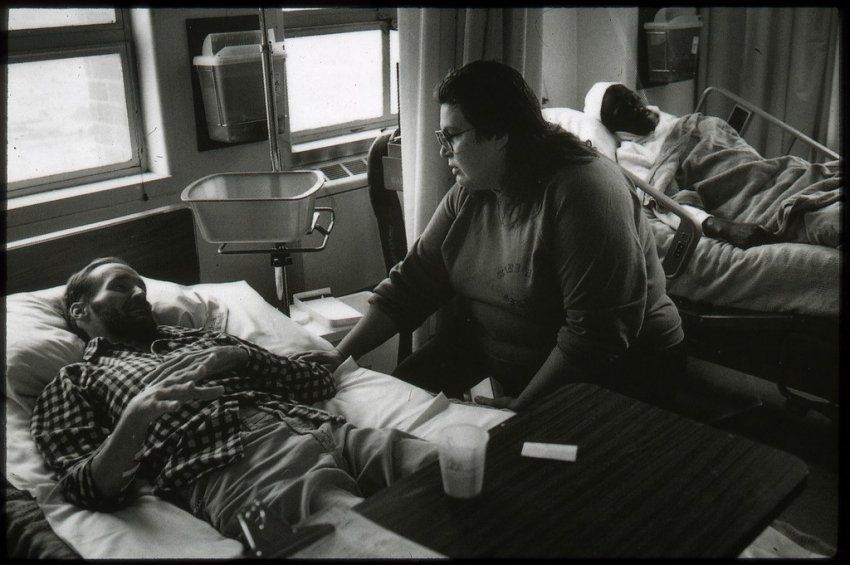
In 1994, San Francisco General Hospital pharmacist Deb Gumbley checks on the condition of an HIV patient participating in a clinical drug trial.
1995
- Jeff Getty, a prominent AIDS activist, receives the first bone-marrow transplant from baboon cells that were transplanted with the hope that the primate’s natural AIDS resistance would boost his immune system.
- CDC issues first guidelines to help health care providers prevent opportunistic infections in people living with HIV.
1996
- UCSF establishes the AIDS Research Institute (ARI) to coordinate and integrate all of the University’s AIDS research activities among more than 60 programs and laboratories with hundreds of scientists from all four professional schools and affiliated labs and institutions, stimulating innovation and supporting interdisciplinary collaboration aimed at all aspects of the epidemic domestically and in at least 67 countries around the world.
- UNAIDS is established.
- Monica Gandhi begins her residency at UCSF, after which she completes a fellowship in infectious diseases and a postdoctoral fellowship at the Center for AIDS Prevention Studies, both at UCSF.
1997
- UCSF’s Donald Abrams, MD, submits request to National Institute on Drug Abuse for a study on potential toxicity of medical marijuana, which was approved in 1998. He later finds that cannabis is helpful for relieving pain in patients with AIDS.
- CDC reports the first substantial decline (47 percent) in AIDS-related deaths in the U.S. compared to 1996, largely due to the use of Highly Active Antiretroviral Therapy (HAART.)
- President Bill Clinton announces goal of finding a vaccine in 10 years.
1998
- CDC reports that African Americans account for 49 percent of AIDS-related deaths in the U.S. and issues first national treatment guidelines for the use of antiretroviral therapy in adults and adolescents with HIV.
1999
- Reggie Williams, founder of the National Task Force on AIDS Prevention, dies of AIDS.
- CDC releases a new HIV case definition to help state health departments expand HIV surveillance and better track the course of the epidemic.
2000
- U.S. and United Nations security councils each declare HIV/AIDS a security threat.
- President Bill Clinton issues an executive order to assist developing countries in importing and producing generic forms of HIV/AIDS drugs; creates first-ever Presidential Envoy for AIDS Cooperation.
- Congress enacts Global AIDS and TB Relief Act.
2001
- UCSF’s Nancy Padian, PhD, MPH, director of international programs at UCSF’s AIDS Research Institute, establishes the UCSF Women’s Global Health Imperative and builds a portfolio of more than 20 research projects in India, Mexico, San Francisco, South Africa and Zimbabwe.
- UCSF’s Merle Sande, MD, co-founds and co-directs the Academic Alliance for AIDS Care and Prevention in Africa, a unique public-private partnership that comprises faculty from Makerere University in Kampala, Uganda, and faculty from UCSF and several other medical institutions in North America.
- Manufacturers of generic drugs offer to produce discounted forms of HIV/AIDS drugs for developing countries.
2002
- The Global Fund to Fight AIDS, Tuberculosis and Malaria begins operations and approves first round of grants led by founding director Richard Feachem, KBE, DSc (Med), PhD, former director of UCSF’s Global Health Sciences.
- The Bill & Melinda Gates Foundation awards $28 million to test whether the diaphragm can prevent the transmission of HIV, to UCSF’s Women’s Global Health Imperative, directed by Nancy Padian, PhD, MPH. The study enrolls women at two sites in South Africa and one in Zimbabwe.
- UNAIDS reports that women comprise about half of all adults living with HIV/AIDS worldwide.
- President George W. Bush announces mother-to-child HIV prevention initiative in Africa and Caribbean.
- HIV is leading cause of death worldwide among those aged 15 to 59.
2003
- President George W. Bush announces the President’s Emergency Plan for AIDS Relief (PEPFAR) and Congress authorizes $18 billion initiative to address HIV/AIDS, making it the largest commitment by any nation for a single disease.
2004
- UNAIDS launches the Global Coalition on Women and AIDS to raise visibility of the epidemic’s impact on women and girls.
- President Bush’s PEPFAR begins awarding funds.
2005
- WHO, UNAIDS and Global Fund to Fight AIDS, Tuberculosis and Malaria announce joint efforts to increase availability of antiretroviral drugs in developing countries.
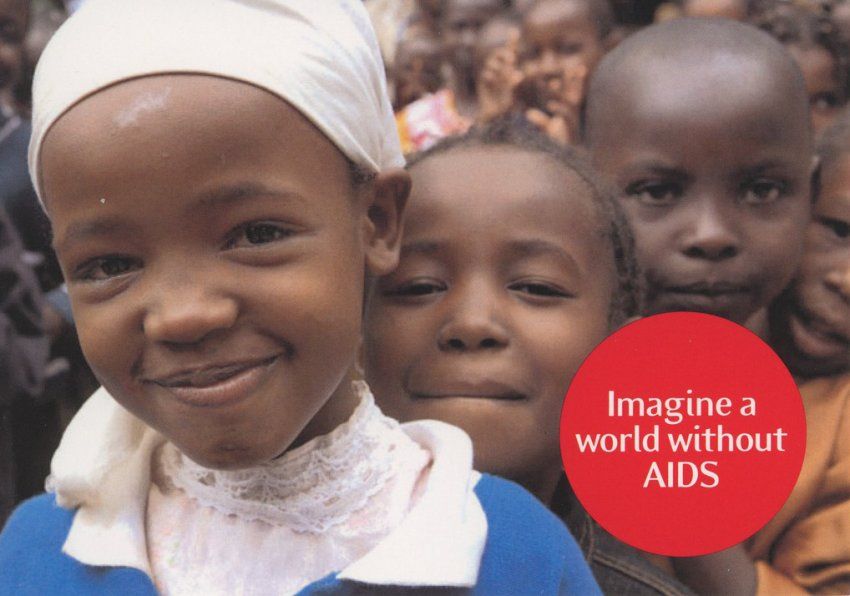
A postcard created in 2006 by the International AIDS Vaccine Initiative urging leaders to commit to better HIV treatment, care and prevention.
2006
- Scientists in the lab of Warner Greene, MD, PhD, director of the UCSF-affiliated GIVI identify a previously unknown function of APOBEC3G (A3G), a protein that acts against HIV, a finding that explains why CD4 T cells – the immune system cells targeted by HIV – are sometimes so susceptible to HIV infection and at other times are highly resistant.
- Jeff Getty, the AIDS activist who in 1995 received the first bone-marrow transplant from a baboon to treat the disease at SFGH, dies on Oct. 9. He was 49.
- The World Health Organization TB/HIV Working Group appoints UCSF’s Diane Havlir, MD, as chair, to develop global strategies to reduce the HIV and TB burden.
- CDC releases new HIV testing recommendations for all adults and adolescents 13 and older.
2007
- Warner Greene, MD, PhD, director of GIVI, is appointed president of the Academic Alliance Foundation, an organization dedicated to fighting HIV/AIDS and other infectious diseases in Africa by establishing and supporting programs of training, prevention and care.
- WHO and UNAIDS issue new recommendation for provider-initiated HIV testing in health care settings.
- CDC reports that more than 562,000 people have died of AIDS in the U.S. since 1981.
2008
- CDC releases new HIV incidence estimates for the U.S., showing new cases are higher than expected – 56,300 new cases every year versus 40,000.
- Congress reauthorizes and expands PEPFAR funding to $48 billion.
2009
- President Barack Obama announces the Global Health Initiative, a six-year, $63-billion effort to develop a comprehensive approach to address global health in low- and middle-income countries with PEPFAR at its core.
- Eric Goosby begins serving as the U.S. Global AIDS Coordinator until mid-November 2013 directing the national strategy for addressing HIV around world and President Obama’s implementation of PEPFAR. It’s estimated that PEPFAR has saved more than 17 million lives through accountable, transparent and cost-effective treatments.
- Congress eliminates long-standing ban on the use of federal funding for needle exchange programs in the U.S.
- An innovative mentoring program at the UCSF-Gladstone Institute for Virology and Immunology Center for AIDS Research is providing vital support for the development of the next generation of HIV/AIDS researchers and clinician scientists.
2010
- CDC estimates that more than 30 percent of new HIV infections were among heterosexuals, including women and injection drug users. Blacks and Latinos are disproportionately affected.
- U.S. removes travel and immigration ban of HIV-positive non-U.S. citizens from entering the country.
- Obama Administration releases first comprehensive National HIV/AIDS Strategy in July. The primary goals of the strategy are reducing incidence, increasing access to care and optimizing health outcomes and reducing HIV-related health disparities.
2011
- June 5 marks three decades since the first reports of diseases that later become known as AIDS in the U.S.
- The U.S. Health Resources and Services Administration funds the UCSF Center for AIDS Prevention Studies to provide leadership and support to seven states implementing interventions to enhance HIV testing and diagnosis.
- CDC launches national HIV testing campaign for young African American and bisexual men.
- Treatment of HIV shown to reduce transmission by 96 percent, demonstrating the concept “treatment as prevention.”
- UCSF’s Paul Volberding produces a mini-documentary titled, “Life Before the Lifeboat: San Francisco’s Courageous Response to the AIDS Outbreak,” featuring intimate conversations with some of San Francisco’s most courageous leaders from the earliest days of the epidemic.
2012
- UCSF names Paul Volberding, MD, director of the AIDS Research Institute at UCSF and the director of research for the UCSF Global Health Sciences program on February 13.
- President Barack Obama appoints UCSF's Grant Colfax, MD, as the director of the Office of National AIDS Policy on March 14.
- UCSF’s Diane Havlir, MD, co-chairs the International AIDS conference, the first time in the U.S. in more than 20 years; UCSF faculty present findings in Washington, DC, in July.
- The SEARCH (Sustainable East Africa Research in Community Health) consortium, a joint venture between UCSF, UC Berkeley, and Makerere University, receives $48 million from the NIH for a new five-year research program to combat AIDS using a “test and treat” approach in East Africa. SEARCH is headed by Diane Havlir, MD Maya Peterson, MD, PhD, and Moses Kamya, MD, PhD.
2013
- San Francisco Department of Public Health adopts RAPID – a clinical approach developed at Ward 86 – to link newly diagnosed HIV patients in San Francisco with antiretroviral therapy (ART) immediately upon diagnosis, ideally the same day.
- The Ryan White CARE Act expires, but Congress reauthorizes PEPFAR, strengthening the program through updated reporting requirements.
- The health advocacy organization HealthHIV conducts a survey of 371 primary care providers in the U.S., including nurses, physicians and other clinicians, that finds that one of the most significant barriers to caring for HIV-positive patients of all ages is that future clinicians lack the training to manage the complexities.
- Inspired by the UNAIDS vision of Getting to Zero – a bold strategic plan announced in 2010 to achieve zero HIV infections, zero AIDS deaths and zero HIV/AIDS stigma – Diane Havlir, Susan Buchbinder and community member Jess Sheehy, the SFDPH and others cross the city, designed and launched Getting to Zero in San Francisco. The consortium began meeting in 2014 and catalyzed new PrEP programs, expansion of the Rapid program, and Retention in care programs .
2014
- UCSF finishes first place among AIDS Walk San Francisco fundraising teams raising just over $80,000, a feat achieved for the first time since UCSF started participating in the walk in 1987.
- CDC releases new reports that find gaps in care and treatment among Latinos with HIV and among gay men diagnosed with HIV.
- UCSF’s Monica Gandhi, MD, MPH, becomes medical director of the HIV clinic at Zuckerberg San Francisco General Hospital, known as Ward 86.
2015
- Mexico City honors UCSF’s Jaime Sepulveda, MD, DSc, MPH, for more than 20 years of work in HIV/AIDS prevention and advocacy for the rights of the LGBT community in Mexico, where he served as director general of epidemiology and then as vice minister of health.
- UCSF’s Steven Deeks, MD, and colleagues publish an HIV infection Primer in Nature with key milestones in the history of HIV research and care. Graphic below.
- CDC announces that 90 percent of new HIV diagnoses are due to people who are undiagnosed or diagnosed but not on treatment.
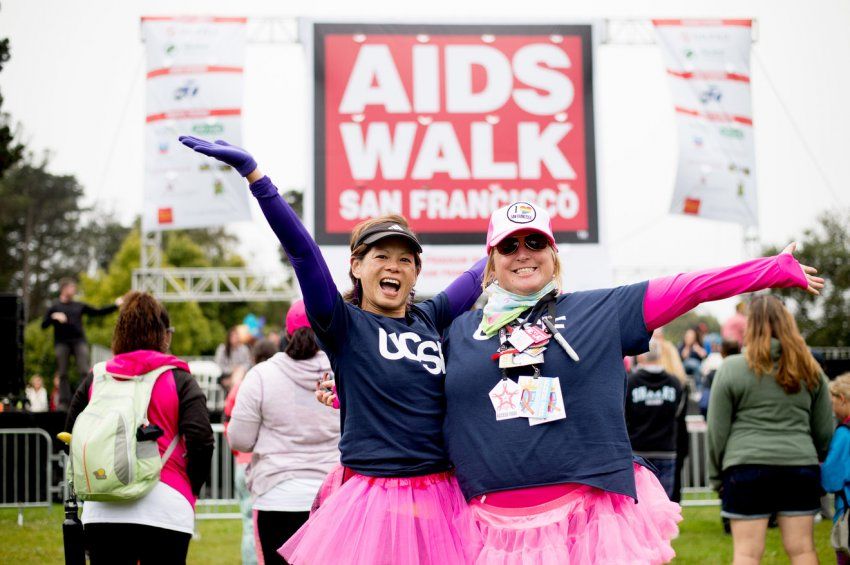
Brenda Gee, of the Office of the Executive Vice Chancellor and Provost, and Jennifer Dowd, of Campus Life Services, added some extra color to the foggy San Francisco morning at AIDS Walk 2016. Photo by Noah Berger
2016
- CDC announces that persistent disparities contribute to burden of HIV among African Americans and that they are least likely to receive consistent medical care.
- New HIV diagnoses in San Francisco reach a record low: 223, representing a 16 percent decrease from 2015, according to an annual report by the SFDPH Population Health Division.
- UCTV produces a video titled, “Diane Havlir: Searching for the End of AIDS,” to profile he work on ending the HIV/AIDS epidemic, from co-founding the Getting to Zero consortium in San Francisco to her Sustainable East African Research on Community Health (SEARCH) study in a fishing village in Kenya.
- The NIH supports the Delaney AIDS Research Enterprise or DARE collaboratory of leading scientific experts including UCSF’s Steven Deeks, MD, who are working with academic and industry partners in launching innovative investigations aimed at developing therapeutic interventions to cure HIV.
2017
- CDC announces that people living with HIV who are on treatment and have undetectable viral loads have effectively no risk of transmitting the virus to sexual partners.
- RAPID is being adapted worldwide, including being part of WHO guidelines to outline a public health approach to managing people with advanced HIV disease and to provide guidance on timing to start ART for all people living with HIV.
- Jeff Sheehy, an AIDS activist and longtime director of communications at UCSF’s AIDS Research Institute, is appointed to the San Francisco Board of Supervisors, representing District 8, by San Francisco Mayor Edwin M. Lee.
- Zuckerberg San Francisco General Hospital launches Golden Compass Program to help older HIV-positive patients navigate health services with support of AIDS Walk San Francisco and San Francisco Department of Public Health.
2018
- First study of PrEP use by race and risk group shows that African Americans and Latinos account for the smallest amount of prescriptions despite comprising two-thirds of people who could benefit from preventive medicines.
- CDC releases estimates of HIV prevalence among transgender people.
- UCSF salutes 35 years of HIV/AIDS care at Ward 86 at SFGH.
2019
- UCSF-Gladstone Center for AIDS Research names UCSF’s Monica Gandhi, MD, MPH, as director of the NIH-funded UCSF-Gladstone Center for AIDS Research (CFAR), a position that supports HIV and AIDS research across all three campuses and affiliates in San Francisco.
- San Francisco reports on the impact and serious threat of COVID-19 pandemic on San Francisco’s HIV community and efforts of “Getting to Zero”
- CDC reports that fewer than 40 percent of people in the U.S. have ever been tested for HIV.
- San Francisco Mayor London Breed and San Francisco Department of Public Health Director Grant Colfax, MD, visit Ward 86 on September 10 to report that despite progress, inequities remain with 20 percent of new infections among unhoused people and that African Americans have poorer health outcomes.
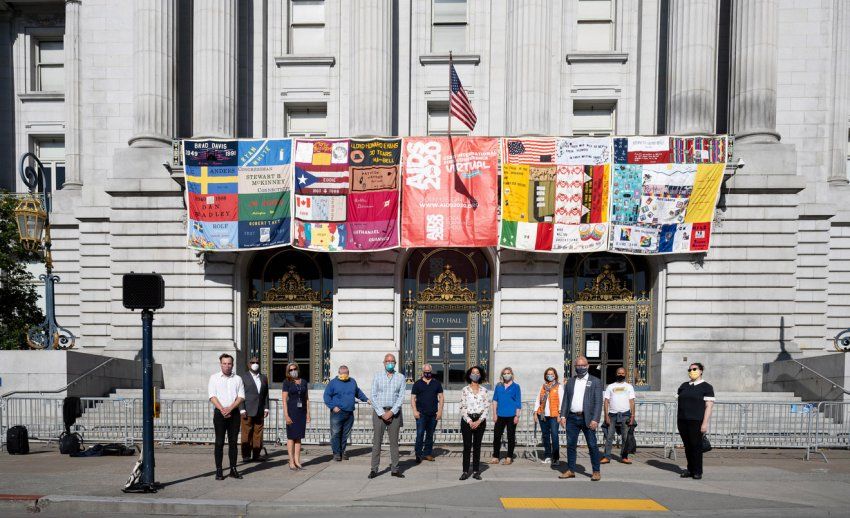
Representatives from the National AIDS Memorial, UCSF, elected officials and the AIDS 2020 Local Planning Group hung an AIDS Memorial Quilt from the balcony of San Francisco City Hall, symbolic of the first quilt panels that were installed there in 1987, to kick off the 23rd International AIDS Conference. Photo by Susan Merrell
2020
- CDC releases frequently asked questions for people with HIV regarding COVID-19.
- With the emergence of the coronavirus, UCSF’s HIV/AIDS specialists pivot to study COVID-19, with experts including Steven Deeks, MD, Diane Havlir, MD, Monica Gandhi, MD, MPH, and others serving on a policy advisory group that has weekly calls with the city about the COVID-19 response.
- In July, UCSF’s Monica Gandhi, MD, MPH, serves as scientific co-chair of AIDS2020, an international AIDS conference hosted virtually in San Francisco and Oakland due to the global COVID-19 pandemic. Among the speakers is Anthony Fauci, MD, director of the National Institute of Allergy and Infectious Diseases, who led the national response to the coronavirus pandemic.
- In September, the SEARCH is awarded $23 million dollars Diane Havlir, MD Maya Peterson, MD, PhD, and Moses Kamya, MD, PhD, to continue work to prevent and treat highly vulnerable populations in East Africa using a multi-disease approach
- Drawing on materials from the AIDS History Project collections preserved in UCSF’s Archives and Special Collections, the UCSF Library presents “They Were Really Us”: The UCSF Community’s Early Response to AIDS, a new digital exhibition on Calisphere that highlights the ways UCSF clinicians and staff addressed HIV/AIDS from its outbreak in the 1980s to the foundation of the AIDS Research Institute in 1996.
2021
- Anthony Fauci, MD, director of the National Institute of Allergy and Infectious Diseases, compares lessons learned in the AIDS epidemic and the COVID-19 pandemic during a presentation for the Center for AIDS Research on April 7.
- UCSF commemorates 40 years of AIDS with a special town hall on June 4.
40 Years of AIDS in SF
Learn about UCSF’s four decades of work in HIV and AIDS, and how it has informed our response to the COVID-19 pandemic.
